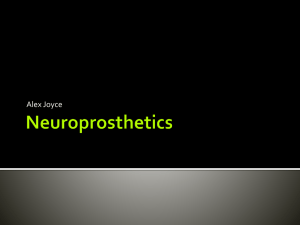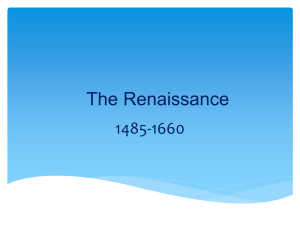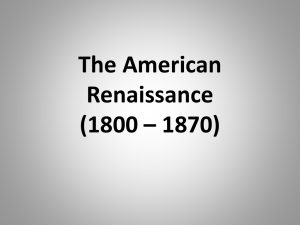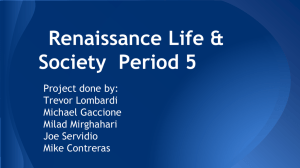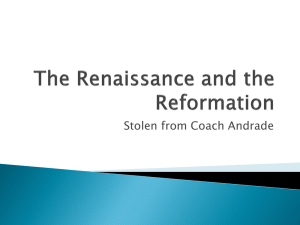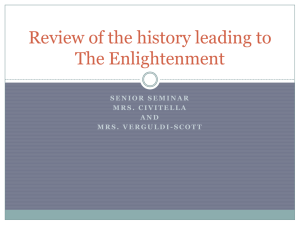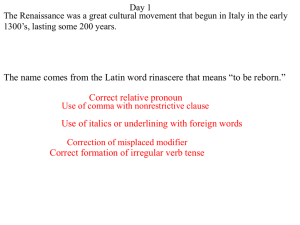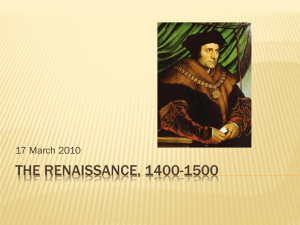H202_2_Early_Renaissance
advertisement
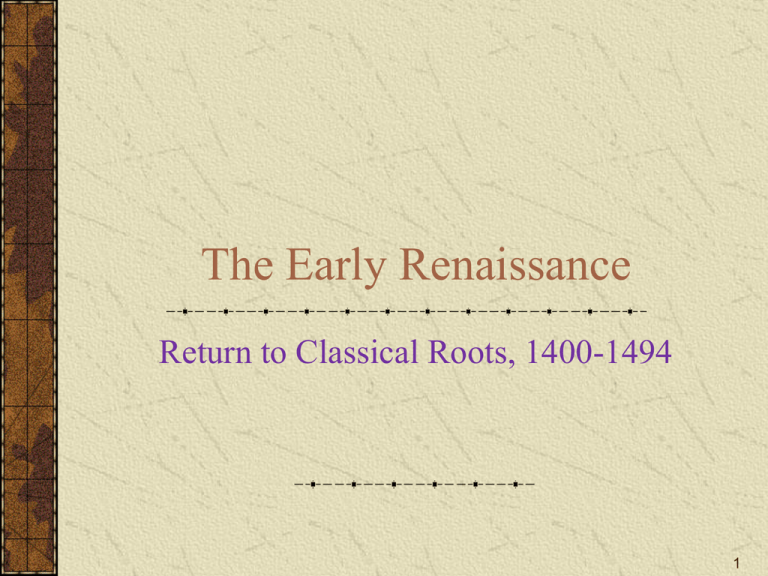
The Early Renaissance Return to Classical Roots, 1400-1494 1 Ready for Rebirth Speaking broadly, the West emerged from “the calamitous 14th century” poised for a real rebirth: Feudal/manorial system starting to crumble; new governmental structures starting to emerge Authority of Church called into question; place of man, roles of faith/reason being re-evaluated New self-assertiveness in architecture/sculpture Individual voice starting to be heard in literature (Dante, Petrarch, Boccaccio, Chaucer) New treatment of nature/human emotion appears in art (Giotto) Technology opens age of exploration The Western World is ready to move in a new direction…and it starts in Italy. 2 Stages of the Italian Renaissance Early Renaissance: 1400-1494 High Renaissance: 1494-1520 Late Renaissance: 1520-1600 3 The Renaissance: Schools of Interpretation Historian Jacob Burckhardt, 1860s: Renaissance a rebirth of ancient ideas and ideals after centuries of cultural stagnation Mid 20th-century historians: a shift in educational and cultural emphasis rather than a rediscovery of antiquity Third interpretation since 1960s: Renaissance label only describes what was occurring in learning and arts, not politics and society 4 The Renaissance: Key Questions Chronology: Overlap on both sides, with Late Middle Ages, Early Modern period, Reformation Meaning: Cultural renaissances common in history (Egypt, Hellenistic Greece, Augustan Rome, “Carolingian Renaissance,” Ottonian renaissance/Pope Gregory VII) Impetus: Much in place in Middle Ages (accomplished scholars, university system, arts faculties, new artistic ideas, revival of Aristotle) 5 What Took So Long? Depended on cumulative growth and spread of wealth never before seen in world history Manpower issues (Decline of slavery, spread of manorial system, famine, Back Death produced labor scarcity) Innovation (wheelbarrow, horse collars, animal breeding, axle, water-mill, wind-mill, sail power --cog/caravel Increased trade and ancillary service (insurance/ banking) Concentration of wealth in cities (Low Countries, Rhine, Northern and Central Italy) Rise of intermediate technologies Development of printing (first efficient, pan-European industry) Italy at center of these developments 6 Early Renaissance: History and Institutions Italian City-States During the Early Renaissance Florence, the Center of the Renaissance The Resurgent Papacy, 1450-1500 7 Italian City States During the Early Renaissance This map shows the states and principalities of Italy in the Early Renaissance. Note (1) the relatively large number of states in the north compared to those in the south and (2) the four forms of government of various states – duchy, republic, kingdom, and papal states. 8 Italian City States During the Early Renaissance General move from strength to relative weakness Gradually eclipsed by nations to North as commercial/woolens manufacturing center • • • • Black Death reduced population, productivity, prosperity Rise of British woolens industry Rise of German banking Incessant warfare (Venice, Milan, Florence, Papal States Naples) • Emergence of signori/decline of business, guild, and middleclass influence Positive: Development of diplomacy • Peace of Lodi (1454-1494); Milan-Florence-Venice 9 Italian City States During the Early Renaissance Shift in balance of power further driven by: Fall of Constantinople (1453) Portugal’s opening of sea route to India (end of century) Columbus’s journey to New World (1492) French invasion of Italy (1494) 10 Italian City States During the Early Renaissance But in midst of broad decline, a moment of glory in ideas and the arts – the Italian Renaissance – driven by: Powerful families The resurgent Church 11 Florence, the Center of the Renaissance Republic > Oligarchy > Family rule Medici Family played central role from 1434-1494: Giovanni > Cosimo > Piero > Lorenzo Medici family driven out by: • French invasion (1494) • Savanarola 12 Savanarola Girolamo Savonarola was a Dominican priest and leader of Florence from 1494 until his execution in 1498. He was known for his book burning, destruction of what he considered immoral art, and hostility to the Renaissance. He vehemently preached against the moral corruption of much of the clergy at the time. Hiss main opponent was Pope Alexander VI (Rodrigo Borgia). 13 The Resurgent Papacy, 1450-1500 Great Schism ended by Council of Constance (1418) Renaissance Popes Nicholas V (1447-55); Vatican Library Pius II (1458-64); New learning Sixtus IV (1471-84); Sistine Chapel 14 The Spirit and Style of the Early Renaissance Key Questions: What is human nature? What is relation between human and divine? What is the best way to achieve human happiness? Sources Greco-Roman tradition 14th century predecessors (Petrarch, Giotto, etc.) 15 Humanism, Scholarship, and Schooling Humanistic studies (moral philosophy, history, rhetoric, grammar, poetry) Textual criticism (Valla/Donation of Constantine) Bruni: History of the Florentine People (history illuminates contemporary events) Vittorino da Feltre: Educational reforms based on Greek schools: physical exercise, solid learning, and moral training 16 Thought and Philosophy Concept of individual worth Move beyond Dogma/Scholasticism Marsilio Ficino: Neo-Platonism Pico della Mirandola: Oration on the Dignity of Man 17 Architecture, Sculpture, and Painting Artistic Ideals and Innovations Break with Late Gothic style Quest for Classical harmony Architecture: Brunelleschi, Alberti Sculpture: Donatello, Ghiberti Painting: Masaccio, Botticelli, da Vinci, Bellini 18 Architecture, Sculpture, and Painting Artistic Ideals and Innovations Architecture : Classical concepts of Dignity, balance, simplicity, control, restraint, mathematical harmony (Alberti) Sculpture : Realism/Classical forms (Donatello’s freestanding figure, contrapposto; life-size nude, equestrian statue) Painting: Various influences (Islam, Late Medieval world, Giotto); linear perspective/atmospheric perspective 19 Linear Perspective 20 Brunelleschi: Dome of Florence Cathedral 21 Brunelleschi: Pazzi Chapel 22 Alberti:Tempio Malatestiano 23 Donatello: Feast of Herod Completed c. 1425, this is the first lowrelief sculpture in the Renaissance style; note the use of linear perspective and the orderly placement of figures throughout the three rooms 24 Donatello: David The frank sensuality of this David undermines traditional allegorical/ Biblical interpretations . To Donatello, David is a youthful, selfaware dandy with his effeminate, undeveloped body, his self-conscious pose and posture, and his incongruous hat and boots. 25 Verrocchio: David Inspired by Donatello’s David, this work impressed Florence’s ruling council so much that they placed it in the Palazzo Vecchio, where it stood until displaced by Michelangelo’s David. 26 Donatello: Gattamelata This is the first equestrian statue created in nearly 1,000 years, and Donatello depicts Erasmo da Narni as a victorious Caesar, calling on nmerous Classical allusions. 27 Ghiberti: Florence Baptistery, North Doors and Annunciation Panel 28 Ghiberti: Florence Baptistery, East Doors and Cain & Abel Panel When Michelangelo first saw these doors, her described them as worthy of Paradise … and his description has stuck. 29 Masaccio: The Holy Trinity In this fresco, Masaccio uses both linear and atmospheric perspective to achieve a remarkable sense of realism and depth. This techique came to full flower only in the 17th century. Not visible in this picture is a skeleton in a wall sarcophagus, painted with the inscription “I was once what you are, and what I am you will also be,” a powerful memento mori probably ordered by the member of the Lenzi family whose tomb lies in front to the fresco. 30 Masaccio: The Tribute Money This fresco, recognized as Masaccio’s masterpiece, follows the narrative form of medieval art, but adopts Brunelleschi’s classicizing principles. Each figure occupies a a precise mathematical space. Note also the contrapposto stance of the tax collector , center and right. 31 Fra Angelico: Annunciation Mary and the Virgin are framed in niches in the Gothic manner, but the mastery of depth, the simplicity of gesture, the purity of colors, and the integrated scene are rendered in the Renaissance style. 32 Della Francesco: The Flagellation This fresco reflects a politicoreligious theme: the hats on Pilate and the third man from the right suggest that the Orthodox church is the persecutor of true Christianity. 33 Botticelli: Birth of Venus 34 Botticelli: Primavera 35 Da Vinci: Virgin of the Rocks This painting, with its carefully observed botanical specimens, is the culmination of the scientific side of the Early Renaissance. Some of its features – notably the grotto setting and the unusual perspective – point to the High Renaissance, and the dramatic use of chiaroscuro foreshadows the night pictures of the Baroque period. 36 Bellini: St. Francis in Ecstasy Bellini, a Venetian, combined the traditions of the Florentine school with those of the Flemish school, and perfected the use of landscape as a backdrop for foreground figures. 37 Bellini: Mehmet II Bellini’s commission for this portrait grew out of a diplomatic exchange between Venice and the Ottoman empire. The portrait blends western technique with Islamic touches – the rounded arch with elaborate design, the sumptuous fabric draped over the balustrade, the turban and furlined robe, and the black background. 38 Encounter: The Influence of Islam on the European Renaissance Can cultures learn from their enemies? Christian Europe and the Islamic world, despite mutually antagonistic religions, did engage in artistic borrowings in the period from 1300 to 1600. These borrowings, though modest for both cultures, were stronger and more enduring in Christian Europe, where Islamic influences helped give shape to the visual and decorative arts in the Renaissance, then in full flower. 39 The Spirit and Style of the Early Renaissance Music John Dunstable Josquin des Prez 40 The Spirit and Style of the Early Renaissance John Dunstable was not just the first truly great English composer, he was also musical godfather to the Renaissance. In the middle of the 15th Century poet Martin le Franc described how Dufay had adopted the English manner championed by Dunstable (la contenance Angloise) and how, to Continental ears, this new style of music sounded so fresh, and above all, joyful. •]osquin des Prez is widely recognized as the greatest of the Renaissance master musicians. He set the standard for the various compositional techniques borrowed and utilized by most composers of his generation and beyond, and became an iconic figure whose art captivated musicians and scholars for centuries. 41 The Legacy of the Early Renaissance Modern times considered to begin with Early Renaissance Drive to individual fulfillment defining trait of Western civilization from this point forward Architecture and sculpture influenced by Classical tradition More artistic freedom in painting—may account for its being the dominant art form even today 42
